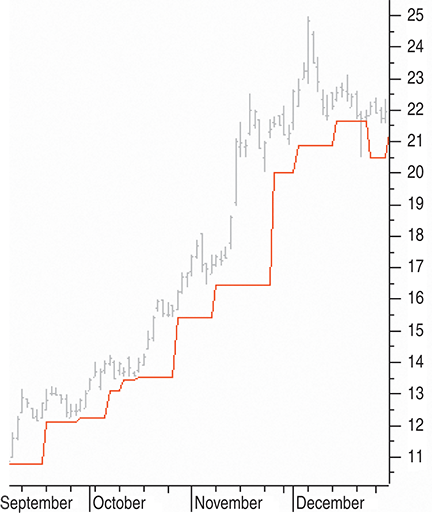TRADING STRATEGIES
Creating Trends
Trailing Resistance &nd Support Stops
In this, the final part of a three-part series, we will look at a short-term trailing stop that moves close to the price action.
The different trailing stops I discussed in parts 1 and 2 allow for enough of a price reaction that makes them most effective for medium-term trend trading. Using lower percentages or a smaller multiplication factor for the average true range (Atr) trailing stop will mostly result in too many losing trades. If you want a short-term trailing stop, it will have to move much closer to the price action. With that in mind, I created Tr&nds, an acronym (more or less) for trailing resistance & support stop, which will look directly at the price movement. The most reliable reference is price support and resistance, and the main item here is price turning points.
Support trailing stop
I define a pivot support point in an up move when there is a low price that is equal or lower than the two prices preceding and following this low price. You can use the following MetaStock expression for this:
support:=If(L>=Ref(L,-2) AND Ref(L,-1)>=Ref(L,-2)
AND Ref(L,-3)>=Ref(L,-2) AND Ref(L,-4)>= Ref(L,-2),Ref(L,-2),{else}
In Figure 1, you can see that this follows the uptrend in the Amd chart. But there are a couple of bigger price moves where the trailing stop stays too far away from the price action. How do we account for them?

Figure 1: pivot support in an up move. Here you see that it follows the uptrend well.
We know that gaps or windows in an uptrend provide support. The low side of the window is the lowest support level. In the next step, I will add code to detect gaps and make use of the gap window support. My tests showed that requiring a minimum window size or setting the stop lower than the previous high only slightly influences the final profit, but it seems to bring down the number of trades by about 3%. Therefore, I set a minimum gap requirement of 0.13% and placed the stop 0.55% below the previous high.